BMT Astoria Line
Overview
The Astoria Line did not come into being until the era of The Dual Contracts, when it and the IRT Flushing Line were constructed to serve the northern part of Queens. These were perhaps the most cooperative portions of the project since both the IRT and BMT would share the routes and operate them jointly.
The original arrangement, beginning around 1920, was that the IRT (now the 7) ran through the Steinway Tunnel, and the Second Avenue El ran over the Queensborough Bridge, and met at Queensborough Plaza. From there, trains ran to either Flushing or Astoria.
Queensborough Plaza Station was built with eight tracks on two levels, served by four island platforms. The BMT operated the northern half of the station and the IRT ran the southern half. The north station had two platforms that fit the wider ten foot BMT subway cars and two for the narrower el cars. The southernmost pair of tracks connected to the Steinway Tunnel, while the next set north connected to the Second Avenue El. Both of these could serve either line in Queens via scissors crossovers west of the platforms on either level. The northerly pair of tracks curved to the Astoria Line and the southerly pair connected to the Flushing Line.
The BMT originally operated to tail tracks west of the station, maintaining the upper level east, lower level west configuration along with Astoria north/Flushing south. This was altered when the 60th St. tunnel was opened and connected to the northerly pair of tracks, which then connected to a easterly tail track for reversing direction. The BMT tracks descended to a lower level east of the station for a flying junction with the IRT. When the Second Avenue El was closed in 1942, the upper portion of the north side fell into disuse, and the lower level was used by IRT subway trains going from Astoria to Times Square. There was a crossover just west of the station which allowed the Astoria trains to access the Steinway tunnels. That crossover was subsequently removed after the joint operation ceased in 1949.
The BMT used rebuilt el cars which were of IRT width on the Astoria line. (Prior to 1942, IRT trains ran from South Ferry via the Second Avenue El across the Queensborough Bridge. The # 3 ran to Astoria and the # 4 to Corona.) After the closure of the Second Avenue El, the # 8 train was on the Astoria Line until 1949 when the BMT took over the Astoria Line. In 1949, it was decided to extend the BMT Subway trains to Astoria and discontinue the joint operation. The Astoria line became BMT-only. A new connection was provided from the 60th St. Tunnel to the former Second Avenue portion of the IRT station, and the platforms were cut back there and along the Astoria Line. The entire north half of Queensborough Plaza Station was abandoned in October 1949, along with most of the flying junction. Disused trackways can be seen descending to the former lower level along both existing lines, but the active trackways are those of the original IRT. The abandoned North half of Queensborough Plaza was torn down in 1964. One set of crossovers remains on the upper level as the Flushing Line's only connection to the rest of the system.
From 1949 to 1955, the 4th Avenue Local, later to become the RR, served the Astoria line twenty-four hours a day. During this time, the Brighton local, later to become the QT, also served the Astoria line Monday through Saturday between approximately 6 A.M. and 7 P.M. From 1955 to 1961, The 4th Avenue Local continued to serve Astoria twenty-four hours a day. The Brighton express ran to Astoria rush hours Monday through Friday during this time as well. From 1961 to 1967, the Brighton local (the QB or the QT) ran to Astoria twenty-four hours a day. The QT ran weekdays from 6 A.M. to 7 P.M. while the QB ran the rest of the time. In addition, the West End express (T) ran to Astoria rush hours Monday through Friday between 1961 and 1967. Beginning in 1967, with the opening of the Chrystie Street connection, the RR provided exclusive service on the Astoria line. For about a year in the mid-1980s, when the Manhattan Bridge was completely closed to subway traffic, the center track was used for express B service in the peak direction during rush hours. In addition, there was express N service that utilized the center track for a period of time also in the mid-1980s. On May 5, 1986, as the remainder of the double letter routes were changed, the RR was renamed the R train.
In 1987, the R and the N changed terminals, and the N was assigned to Astoria service, and continues to run on the Astoria line to this day. On August 15, 2001, due to reconstruction of the Manhattan Bridge subway tracks, several trains were rerouted and added, including a new W train, whose northern terminal is Ditmars Boulevard. The W made express stops along the Astoria line in the rush hour direction, until, responding to customer complaints, the MTA performed a study and discovered the W was underutilized while the N had become more crowded during rush hours. As a result, on January 15, 2002, the W began making all local stops along with the N train on the Astoria line at all times. This situation continued until September 8, 2002, when, due to the reconstruction of the Stillwell Avenue terminal, the W train began to serve the Astoria line exclusively on weekends and late nites, leaving the N train running along the Astoria line only on weekdays and evenings.
When construction on the Manhattan Bridge was finally completed in 2004, trains were once again allowed to run on both the north and the south side of the bridge. As a result, beginning on Sunday, February 22, 2004, the routes of many subway lines were changed, including the N and the W. The N train has resumed running locally at all times along the Astoria line while the W train now only serves the Astoria line on weekdays and does not run on weekends or late nights.
The Astoria line is entirely elevated and consists of three tracks, including one express track that begins just south of the 39th Avenue/Beebe station. There are seven stations on the Astoria line, including Queensborough Plaza, all of which opened for service on July 19, 1917. The terminal stop on the line is Ditmars Boulevard, which consists of one island platform and two tracks. The Astoria Boulevard/Hoyt Avenue station has two island platforms and three tracks, while 30th Avenue/Grand, Broadway, 36th Avenue/Washington, and 39th Avenue/Beebe all are serviced by two side platforms and three tracks.
The Astoria elevated continues to be of vital importance to the neighborhood of Astoria, Queens. It provides a rapid link with Manhattan, and continues to bring vitality and growth to the neighborhood.
Opening/Closing Dates
| Station | Opened | Closed |
|---|---|---|
| Queensborough Plaza | 4/21/1917 | |
| 39th Avenue-Beebe Avenue | 7/19/1917 | |
| 36th Avenue-Washington Avenue | 7/19/1917 | |
| Broadway | 7/19/1917 | |
| 30th Avenue-Grand Avenue | 7/19/1917 | |
| Astoria Boulevard-Hoyt Avenue | 7/19/1917 | |
| Ditmars Boulevard | 7/19/1917 |
Station by Station
Queensborough Plaza
Artwork Columns (Sydney Cash, 2000)
Transfer to BMT Astoria Line, IRT Flushing Line
7NW![]()

Two levels; one island platform and two tracks on each level. This station is shared between the IRT Flushing Line and the BMT Astoria Line, and is unique in being the only station with across the platform transfer between the BMT and IRT and their differing car width specifications. The station's upper level serves Queens-bound trains, and the lower level serves Manhattan-bound trains. The Flushing line train uses the southern track on each level. The lower level has walls on the track-side edge, with windows of frosted wire glass on the upper half of both walls. From this level, there's another flight down to a mezzanine which has a concrete ramp across Queens Plaza North to the second floor of a building. A new computer-assisted tower is being installed in a new structure on the south end.
 Photo by: David Pirmann |
 Photo by: Robbie Rosenfeld |
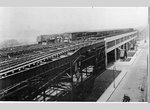 Collection of: Herbert P. Maruska |
 Collection of: George Conrad Collection |
 Photo by: Bill E. |
| More Images: 1-50 51-100 101-150 151-200 201-250 251-300 301-350 351-400 401-450 451-500 501-550 551-600 601-643 | ||||
39th Avenue-Beebe Avenue
Artwork Hellion Equilibrium (Sarah Morris, 2018)
NW Two side platforms, three tracks. Full windscreen treatment along the platform. The exit to the mezzanine is in the center and is accented with bright blue at the top of the stair cutout. The back of stairs are red as are the skirt boards of the stairs and the lower woodwork in the mezzanine. The mezzanine itself is clad wood and has an extra exit to the west. There is a free crossunder. A view of Sunnyside Yard can be had through peepholes in the windscreen and from the mezzanine. The rails around the stairs are light blue in color. A two story tower is just to the south of the station in between the two tracks, the third track ending just north of this tower. The station is 2.5 stories above the ground.
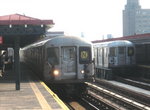 Photo by: Gary Chatterton |
 Photo by: Roberto C. Tobar |
 Photo by: David-Paul Gerber |
 Photo by: Nicholas Noel |
 Photo by: David Warner |
| More Images: 1-50 51-100 101-150 151-200 201-205 | ||||
36th Avenue-Washington Avenue
Artwork Crystal Blue Persuasion (Maureen McQuillan, 2018)
NW Two side platforms, three tracks. Windscreen treatment on the northbound platform only. The mezzanine and trim is like 39th Ave. with the addition of a fairly generously-sized newsstand/convenience store in the mezzanine on the north side. The old light posts now feature new lights. There is a free crossunder.
 Photo by: David Pirmann |
 Photo by: Peter Ehrlich |
 Photo by: Aliandro Brathwaite |
 Photo by: Robbie Rosenfeld |
 Collection of: David Pirmann |
| More Images: 1-50 51-100 101-150 151-199 | ||||
Broadway
Artwork Outlook (Diane Carr, 2018)
NW Two side platforms, three tracks. The features resemble 39th Ave. with the exception of the fare control arrangement in the mezzanine. There are separate fare controls leading to each platform, but there's an open space behind the service booth. If you walk behind the booth you can cross to the other platform.
 Photo by: David Pirmann |
 Photo by: Steve Zabel |
 Photo by: Roberto C. Tobar |
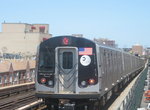 Photo by: Gary Chatterton |
 Photo by: DeAndre Burrell |
| More Images: 1-50 51-100 101-150 151-168 | ||||
30th Avenue-Grand Avenue
Artwork Perasma I and II (Stephen Westfall, 2018)
NW Two side platforms, three tracks. In the mezzanine, there are separate fare controls leading to each platform, but there's an open space behind the service booth. If you walk behind the booth you can cross to the other platform.
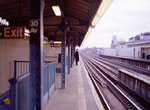 Photo by: Jill Reichenbach |
 Photo by: David Pirmann |
 Photo by: Christopher Esposito |
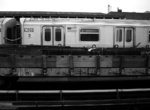 Photo by: Zach Summer |
 Photo by: Zach Summer |
| More Images: 1-50 51-100 101-150 151-200 201-242 | ||||
Astoria Boulevard-Hoyt Avenue
Artwork I Am A Rainbow Too (Jeffrey Gibson, 2019)
NW![]() Express station, two island platforms and three tracks. There is a
covered waiting area on the Manhattan-bound island platform. The exit
is in the center. There are twin fare controls but a crossunder is
behind the booth. The westbound platform has a sign giving this
station the tertiary name of Columbus Square. We have two postcard
views from the platform; to the west is the suspension span of the
Triborough Bridge and to the east is the Grand Central Parkway in an
open cut layout and the Brooklyn Queens Expressway. In an interesting
layout, there is an extended exit from the east island
platform. Features are like Broadway with respect to design.
Express station, two island platforms and three tracks. There is a
covered waiting area on the Manhattan-bound island platform. The exit
is in the center. There are twin fare controls but a crossunder is
behind the booth. The westbound platform has a sign giving this
station the tertiary name of Columbus Square. We have two postcard
views from the platform; to the west is the suspension span of the
Triborough Bridge and to the east is the Grand Central Parkway in an
open cut layout and the Brooklyn Queens Expressway. In an interesting
layout, there is an extended exit from the east island
platform. Features are like Broadway with respect to design.
This station was the site of an accidental demolition of a large section of the mezzanine in May 1998. Early on a weekday morning, a backhoe working underneath the station (not performing NYCT-related work) struck the mezzanine ripping out three support beams and damaging four more, creating a huge hole in the mezzanine floor. No one was hurt; in fact, trains continued running through the station with slow speed limits in place, but did not stop. Cleanup work began immediately and by noon, the slow speed was removed. By 3pm, a temporary wood floor had been installed. Less than eight hours from the time of the first response the station was back in full service. Permanent repairs were made overnight. The mezzanine demolition accident proves that New York City Transit workers are truly capable of herculean efforts to restore/maintain service in cases of service disruption.
 Collection of: Joe Testagrose |
 Photo by: John Barnes |
 Photo by: DeAndre Burrell |
 Photo by: Bill E. |
 Photo by: Chao-Hwa Chen |
| More Images: 1-50 51-100 101-150 151-200 201-232 | ||||
Ditmars Boulevard
Artwork Urban Idyll (Elisabeth Condon, 2018)
NW Two tracks and an island platform, partially located under the Hell Gate Bridge. In an odd layout, the station has a canopy for the portion under the bridge! The mezzanine has twin fare controls, with double wide stairs. There is a pedestrian bridge to the adjacent Garry Building's second floor. A view from the platform reveals a painted mural on the east wall of the bridge entitled Americana.
 Photo by: David Pirmann |
 Photo by: Robbie Rosenfeld |
 Photo by: Robbie Rosenfeld |
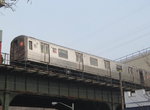 Photo by: Jose Garrido |
 Photo by: Jose Garrido |
| More Images: 1-50 51-100 101-149 | ||||
Page Credits
By Adam Weiss, Peggy Darlington, and David Pirmann. Thanks to Gerry O'Regan and Ed Sachs. Queensborough Plaza track diagram by SPUI at wikimedia commons.